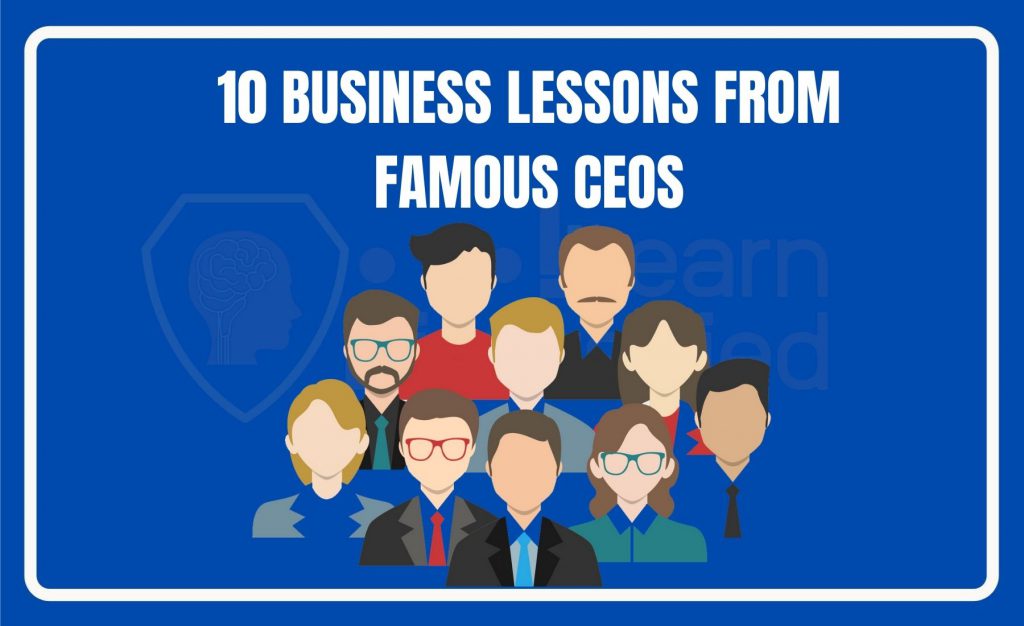The world is changing, the business’s are changing, the consumers are changing, the lifestyle is changing, the food we eat is changing, dress we wear is changing, purchasing environments are changing — It is always a volatile environment. Companies adapting to the changes, survive. Some companies keep running all the time but they stay in the same place. THEY JUST SURVIVE.
But few leaders make their company swim against the tide and keep it moving forward and grow better. They pull everyone forward along with them. They aim for a better payoff for all their efforts.
Business Lessons from top CEO’s
1. Be the customer yourself
- CEO of Pepsico, Indra Nooyi insisted her employees not to be representatives of customers but being customers themselves. She often visited retail stores as a common customer and would experience the business from a customer point of view. She also encouraged everyone to do the same.
- Harley Davidson encourages the culture where their employees are recommended to become riders so that they could understand their customers more.
- Phil Knight and Billy Bowden, Nike’s founders were athletes. They understood and observed the problems faced by athletes and professional sports personalities with the shoes as they had the same experience.
2. Give attention to the details
The ‘attention to the details’ are directly proportional to the customer feel and delight about the product and service.
- During the designing process for the packaging of Doritos, Indra Nooyi and her employees they had a special observation that, when the Doritos were almost over men had the tendency to raise and empty the packet whereas women would no do so as they are very much decency-conscious. Hence, the packaging was designed in such a way that the consumers could take out all the Doritos down to the last 5%. The packaging also would fit in a women’s purse.
- While making Snow White and Seven Dwarfs, Walt Disney constantly worked on little details so that he could provide an impressive, distinctive and memorable ‘movie experience’. He frequently asked his team to evolve the characters of Queen, Snow-White, Dwarfs and make them realistic. He brought live animals into the studio so that his artists could study them in detail and understand their movements.
3. Listen and Listen
The founder of Wal-Mart, Sam Walton used to meet his employees in his stores and listen to their concerns and opinions. He also met his truck drivers as often as possible in the early morning at 4AM with a box of doughnuts and lend his ears to them for couple of hours. He loved spending time with the employees.
4. Be committed
Carlos Ghosn, CEO Nissan announced a “Nissan Revival Plan” in 1999 and gave one-year, Two-Year and Three-Year plans. He went ahead and publicly announced that he would resign if the company did not turn profitable within one year. His public commitment made many employees believe in him. They understood the seriousness. People don’t like change unless that commitment is there.
5. Responsibility and freedom
Many organizations become successful because the employees are responsible for breakthrough customer experiences and the employees are shaped by the organization’s culture.
-
Walmart’s CEO, Sam Walton, considered people working in his stores, warehouses as partners and called them ‘associates’ rather than employees. He firmly believed that the more he shared profits with his associates, the more profit the company would gain. If the company could treat the associates well, then the associates would treat the customers well. If the customers were treated well, then they would visit the store repeatedly.
“Real profits in business lie in ‘repeat customers”
Sam shared all information about the business to his associates and involved them in the business decisions, planning, and execution. He gave his associates freedom, authority and responsibility. Hence, they became very successful.
6. Finding Good People or ideas
The CEO of Pixar, Ed Catmull suggests that the central problem in a business is not finding the good ideas but finding the good people.
In 1996, Pixar was asked to make ‘Toy Story 2’ movie. Unfortunately, the team who made the earlier Toy Story movie were occupied in making of ‘A Bug’s Life’ movie. Ed Catmull then formed a new creative team of people to make the sequel.
Due to the circumstances, the making of ‘Toy Story 2’ movie did not go as expected. The story was not coming out well. After ten months, Ed Catmull was forced to take a call and replaced the team with the original ‘Toy Story 1’ team. The team began the movie from scratch. They had only eight months to finish the project. They successfully did and the movie was a massive success. The CEO points out that the original core concept(The Idea) of ‘Toy Story 2’ was same for both the teams but the people made the difference.
7.Communication structure
Ed Catmull, CEO, PIXAR has written that we have confused organisational structure with the communication structure. He says that organisation structure might be important for better control and on-time completion of projects. But communication need not follow organisation structure. Communication needs to be able to happen between anybody at any time. There should be an open door policy. Anybody can go to the head of the company and talk about his concerns, ideas. Flat organisation will be a better idea for a successful organization.
8. Accept the truth
Kimberley-Clark was in bad financial shape when Darwin Smith became its CEO in 1970s. Smith confronted the ‘Brutal Truth’ that the traditional core business of ‘Kimberley-Clark’, the coated paper was doomed to fail. It was no more viable to compete in that market. Smith took the decision to sell the mills. Everyone was shocked. He sold all the mill, threw all the proceeds into the consumer business, investing in brands like Huggies and Kleenex.
9. Crowd-sourcing from inside the company
Nissan CEO, Carlos Ghosn says that to turn around a struggling company, the solution has to come from inside the company. External consultants might be equipped with better insights & experience and might have better solutions. But when it comes to execution, there would be resistance from within the company. Motivational levels would be low. If the idea came from inside the company, it would be easy to make the employees buy the idea. The employees would further work wholeheartedly in implementing the same.
10. Do what is RIGHT
When Lou Gerstner became CEO of IBM, the company was struggling. Everyone was of the opinion that IBM had to be broken into small business units. Many believed that IBM could no longer compete as a single firm. Analysts pointed out a lot of instances where companies like Microsoft made only software, Intel made only processors, Oracle made only business database software. In fact, Gerstner’s predecessor had initiated steps to break down the IBM into small units.
Whereas Gerstner saw IBM’s strength was its size and breadth. Every other competitor was small compared to IBM’s bigger size. IBM was good at delivering combined solutions for hardware and software rather than specialising in any one field. Due to Size, IBM could provide solutions to big corporates on a global scale and also provide better service and support to the clients. Gerstner decided that the best way forward for IBM was to provide an integrated solution. He shocked everyone. In a couple of years, IBM became profitable.
YOU DONT HAVE TO BE GREAT TO START, BUT YOU HAVE TO START TO BE GREAT -Zig Zigler
Click here for more articles

